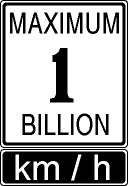

 Observe Laser Stars
Observe Laser Stars

This confirms one of the predictions of the laser star theory (Varshni 1979) : Laser action in the hot plasma of rapidly cooling stellar atmospheres is responsible for the unusual emission lines in quasar spectra, there is no redshift. There is no superluminal motion in quasar jets because their distance has been overestimated : quasars are within the galaxy, therefore their jets travel at reasonable sublight speeds.
As an example of the historical importance of proper motion studies, consider the 17th century observations of the satellites of jupiter by Galileo. These startling results, easily reproducible by amateur astronomers today, were a turning point in the history of science. It proved that certain objects are not orbiting the earth. Although it was ignored by the scientific/religious community, this crucial piece of observational evidence would play a key role in the dismantling of the geocentric model of the solar system. More importantly, it firmly establishes the importance of observation in modern empirical science.
 "In questions of science the authority of a thousand is not worth the humble
reasoning of a single individual."
"In questions of science the authority of a thousand is not worth the humble
reasoning of a single individual."
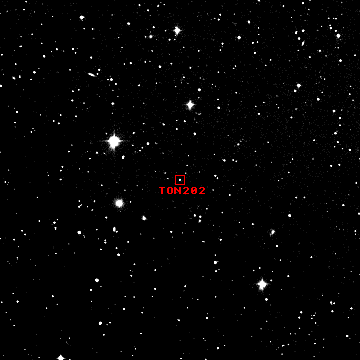
|
Quasar TON 202Finder chart for quasar TON 202. Located 4 degrees west of epsilon Bootes, plotted as 1425+267 on p.152 Uranometria which plots the five brightest stars. Field of view is 30 arcminutes across, the size of the full moon. Image scale is 5 arcseconds per pixel. TON 202 is moving towards the lower left part of the image at a speed of a pixel per century. It will move out of this image in less than 25,000 years. (Image courtesy DSS; Digitized Sky Survey) |
Meyer et al. (1995) discuss amateur astrometry; All you really need is a CCD camera, a telescope with a clock-drive and some software. Using this new technique Dennis di Cicco tracked the proper motion and annual parallax of a faint star light years away. Paul Boltwood, of the Ottawa Center Royal Astronomical Society of Canada received the Chant Medal for his work on quasar photometry using only a small 7-inch telescope and a home-built CCD camera.
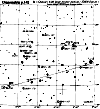 Star Finder Chart
Star Finder Chart
 Proper Motion Chart
Proper Motion Chart
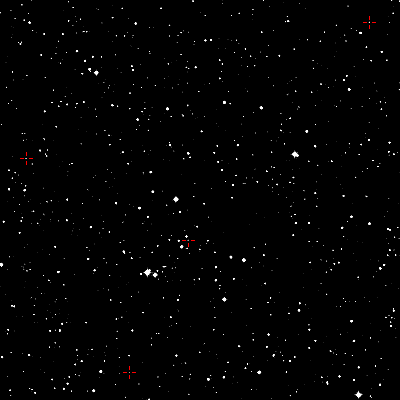
|
Quasars in CancerAstrophoto of exact location for LB 8956, LB 9029, LB 8991, LB 9010 (small red crosses from top to bottom respectively). Field of view is 33 arcminutes across. Image scale is 5 arcseconds per pixel. (Image courtesy DSS; Digitized Sky Survey) |
The easiest way to detect quasar proper motion is to measure the pixel distance between two or more quasars within the same CCD frame. The standard quasar theory claims that quasars are so distant that there should be absolutely no detectable change in this value with the passage of time. If the value changes in a regular and systematic way, this would confirm that quasars are objects within the galaxy.
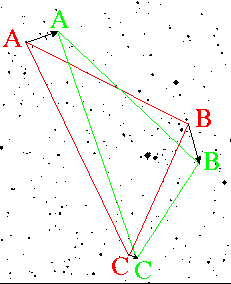
|
Triangle DistortsThe red triangle is the present day angular distances between quasars LB 9029(A), LB 8991(B) and LB 9010(C). The green triangle represents these distances 3500 years later. Image scale is 5 arcseconds per pixel (the red AB side is 15 arcminutes, small enough to fit on most amateur CCDs). |
The geometry of the red triangle is distorted after a few thousand years of proper motion into the green triangle. There is a significant change in both angles and distances. In particular note how the green triangle's BC side is shorter than the red triangle by 20 percent. This indicates that the distance between quasars LB 8991 and LB 9010 is becoming smaller over the passage of time due to the relative proper motions of both quasars; it decreases from 12 arc minutes to 9.5 arcminutes in the figure. This rate of change is equivalent to one half a percent per century, therefore observations over the span of many years must be carried out.
The three quasars in the figure lie within 20 arcminutes from each other. Amateur astronomers could capture all three quasars simultaneously within the same CCD field of view if it covers at least 16 by 13 arcminutes. By carefully orienting the CCD, all three quasars should be able to fit at the three corners of the chip. There are a dozen more quasar triangles that can fit on a CCD chip.
These startling findings throw serious doubt on the published distances to many other supposedly well known objects. These humbling results confirm that astronomers still have a very long way to go before obtaining reliable distances or proper motion estimates of most astronomical objects (including quasars).
Revised Distances to Well Known Objects | |||||
|---|---|---|---|---|---|
| Popular Name | ID | Old Distance (light years) |
New Distance (light years) |
Error (percent) |
Reference |
| Stars in our Galaxy | |||||
| Gamma-2 Velorum | MR 12 (WC8) | 1500 | 850 | +43.3 % | van der Hucht et al. |
| Beta Pictoris | IRAS ... | 53 | 63 | -18.9 % | Crifo,F. et al. |
| Praesepe (Beehive) |
M44 | 522 | 577 | -10.5 % | Mermilliod,J.-C. |
| Coma Berenices cluster |
Mel 111 | 260 | 288 | -10.7 % | Mermilliod,J.-C. |
| Acturus | Alpha Bootes | 34 | 37 | -8.8 % | Garrison,R.F. |
| Alpha Persei cluster |
- | 554 | 601 | -8.4 % | Mermilliod,J.-C. |
| Pleiades cluster |
M45 | 408 | 380 | +6.9 % | van Leeuwen,F. |
| Second Nearest Star |
Alpha Centauri A,B | 4.3 | 4.40 | -2.3 % | Garrison,R.F. |
| IC2602 | - | 489 | 479 | +2.0 % | Mermilliod,J.-C. |
| Altair | Alpha Aquila | 16.5 | 16.8 | -1.8 % | Garrison,R.F. |
| Extragalactic Objects | |||||
| Andromeda Galaxy |
M31 | 2,300,000 | 2,930,000 | -27.4 % | Feast,M.W. |
| Large Magellanic Cloud |
LMC | 166,000 | 180,000 | -8.4 % | Feast,M.W. |
| Great Spiral Galaxy |
M101 | 24,000,000 | 27,000,000 | -12.5 % | Paturel,G. |
![[ Einstein's Caricature ]](../humour/einstein.gif)
